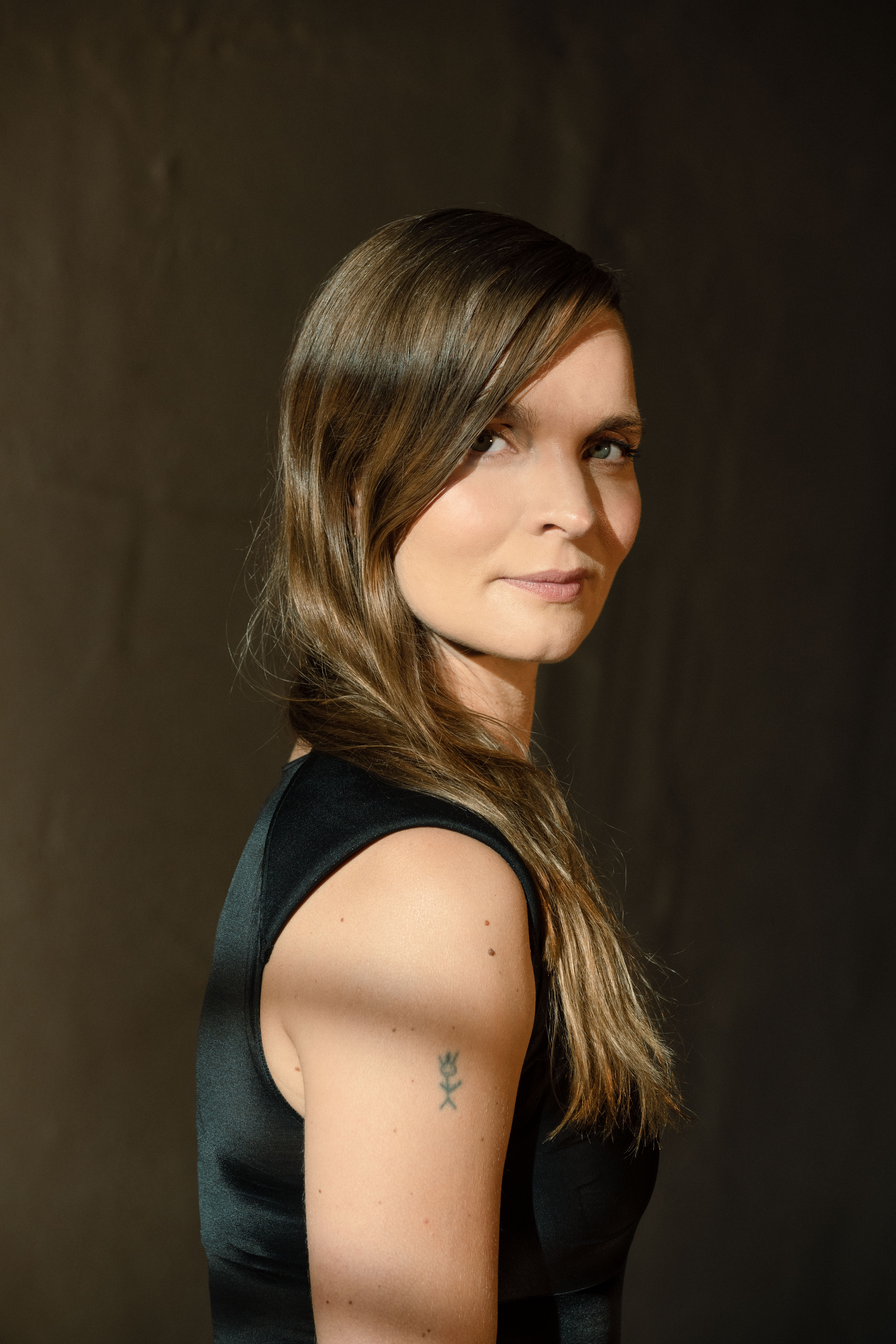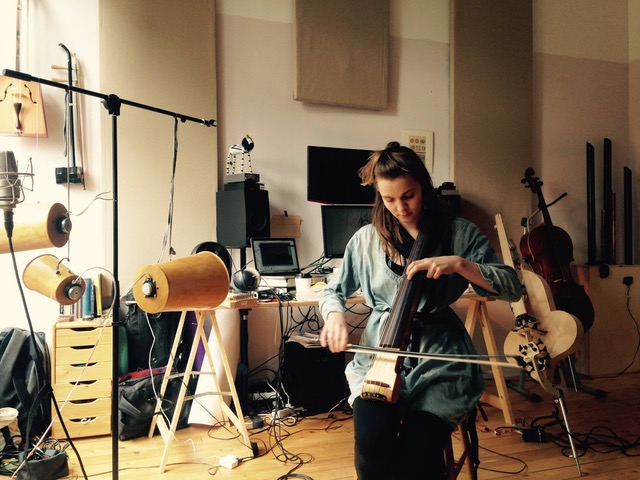How did you choose which kind of instrument you play? Did it even feel like a choice? For Hildur Guðnadóttir, it was like some sort of mystical Icelandic story. Her pregnant mother listened to a lot of Jacqueline du Pré, the celebrated cellist most famous for her interpretations of Elgar’s Cello Concerto, and she said she knew the child she carried would be called Hildur—the name means “battle,” reflecting du Pré’s lively playing style—and that Hildur would be a cellist.
“Everyone in my family is pretty much a musician,” Hildur explains, “so my mother said that when it came to me choosing my instrument, I picked up the cello myself, without any influence from her at all. I’m not sure I really believe that,” she says, laughing, “but that’s what she says.”

Now approaching 40, she’s sure she made the right decision—whoever was responsible. “It’s quite funny,” Hildur says, ”because I’ve been playing music my whole life, and all of a sudden in recent years there was this big explosion that happened.” She smiles at her own description, as well she might. The epicenter of that big explosion was the 2019 movie Joker, which bagged Hildur’s score an Oscar, a Grammy, a Golden Globe, and a BAFTA. The kind of thing that might knock anyone sideways.
Hildur grew up in Iceland, played cello from an early age, studied in Berlin, and began working there as a musician, establishing a space in a studio built by a crew of experimental composers in the city’s Kreuzberg district. Later she moved with Sam Slater, her husband and regular musical collaborator, to two production rooms they built in an old piano factory in the north of the city. She worked with experimental bands such as Múm and Throbbing Gristle, with Dirk Dresselhaus’s project Mr. Schmuck’s Farm, and with composer Jóhann Jóhannsson, among others.
Hildur made four solo albums for Jon Wozencroft’s Touch label, and with Sam she scored the TV mini-series Chernobyl, another Grammy winner, and the climate-disaster-war game Battlefield 2042. Joker followed her earlier scores such as A Hijacking (2012) and Mary Magdalene (2018), but the explosion of success with Joker was contrary to anything she’d experienced before. Suddenly she was popular, and while she says it was funny, she found the public eye an unsettling intrusion.
“I’m not a very public, outgoing person, in that sense. So it’s been an interesting balance to try to keep the space and the energy for my work. Of course, the benefit, which I’m so grateful for in the last few years, is that this sudden popularity has brought a variety of projects to my plate, so I can choose a little bit.”
For example, she recently finished scores for two movies due this fall: Tár, intriguingly starring Cate Blanchett as a composer, and Women Talking, with Frances McDormand. “Actually,” she adds, “I’ve always chosen what I do. I’ve never done music in order to make a lot of money or be popular. I’ve pretty much always chosen projects that I find interesting.”
During her studies at the Universität der Künste Berlin, she’d spent a great deal of time with electronics. “I spent a whole year programming, hours and hours of work, until I got a little ‘beep’ sound. Some people are amazing at that—they can do that as if they’re playing an instrument. But it was so unsatisfying for me.”

When she stopped studying and started composing music, the cello had been sitting in the corner, but one day she thought she might practice a bit, just for fun. “I got instant sounds, which was so gratifying. It seemed like this most magical thing after programming for a whole year! Something beautiful happened, and I completely fell in love with the cello.”
She returned to the cello with what she calls a beginners’ mind, and her style, in tandem with her own compositional flair, has developed through an experimental frame of mind and a willingness to explore far and wide. “I had cleared my cello palette, after not having played it and studied it for a while. So I was able to be very open, and because I’d been studying experimental music and living in the world of experimentation and exploration, I brought that mindset to the cello again. I became very interested in not playing like a soloist, not playing like the way you’re necessarily supposed to play, not playing like a proper classical player. I started to play in a way that resonated with me.”
At the heart of her orchestral Joker score was the cello, and in this case an unusual kind. It was a dorophone, an electro-acoustic feedback instrument designed by Halldór Úlfarsson, an old friend from Iceland and not a conventional instrument builder. More of a DIY artist. “In Icelandic we’d call it a shitmix,” she says, “meaning stuck together. When the gaffer tape is your best friend, you’re probably pretty good at shitmixing. Halldór is an amazing shitmixer, he can make pretty much anything work in a brilliant fashion. Maybe not the ‘right’ way, but probably some very inventive way.”
The dorophone (sometimes called the halldorophone) has four strings like a regular cello, but each has a pickup, and there is a speaker on the rear and four sympathetic strings, also with a pickup each, all designed to generate feedback and drones. A panel to one side offers mixing controls for the pickups, and there is scope for pedal control. “I always call it a Jimi Hendrix cello,” she says, laughing at the idea. “It can get pretty loud and rowdy, but you can also play this thing acoustically.”
She played it on some of Jóhannsson’s score for Sicario (2015), and again for the recording of her Joker score—sometimes the droning, electronic qualities of the dorophone, but for the main theme she played it like a regular cello. “In the most recognizable and famous scene, ‘Bathroom Dance’, I played it that way, and it doesn’t sound like a fantastic classical cello. It sounds a bit boxy and thin and nasal—and if it was an acoustic cello, people would probably say it sounds pretty crap. But that’s also what I like about it. ”
A regular cello is a very physical instrument to play. “It’s like you’re cradling it with your whole body. It sits on your chest so it resonates with your lungs and the way you breathe. It’s very all-encompassing to play the cello. And I became interested in amplifying it and expanding the possibilities that it had, with both acoustic playing and amplification, and all kinds of processing. And because I was playing lots of electronic music at the time, the cello came along with me into that journey.”
Her trusty regular acoustic cello was made in 1987 by David Wiebe in Woodstock, New York, but as well as the dorophone, she has another experimental instrument on hand, a further result of a collaboration with an Icelandic friend, this time the master violin and cello maker Hans Jóhannsson.
“I’m developing an instrument with him that I call Ómar,” she says. “It’s a six-string cello with frets, so a little more in the viola da gamba direction. It has a modular body, so there are parts that you can put on but also that you can take apart and move around the place, almost like a surround instrument. Very modular. It’s another instrument we’re still very much in the process of developing.”

Hildur describes the Ómar as an activator, because it can make other objects resonate. There’s a track on her 2014 album Saman called ‘Heima’ where she plays a plucked part on the Ómar and sings, with Skúli Sverrisson on bass. “I’m playing the Ómar part ‘through’ two grand pianos,” she reports. “You don’t hear the pianos at all, but I’m using the pianos as resonators, like reverb bodies.”
Experimentation can be a risky business, of course. She recalls an occasion with her dorophone in 2017 when she played London’s Barbican Hall with Sunn O))). “What you’d call a doom metal band,” she says with a smile, “very, very loud concerts, with a pretty preposterous setup of amplifiers. In that setting, I’m focussing on the more drone-y directions that you can go with the dorophone. In the loud direction.”
At the Barbican gig she opened the evening solo, as well as playing with Sunn later. “On I went, I’m making sounds, and all of a sudden there was a farting, like crackling. Oh my god, what’s going on! It really keeps you on your toes, this instrument, you’ve no idea when it might start doing something completely different to what you expect. And I like that. Everything can change within a second, so you have to be super alert. It’s very fun.”
What happened next? “I realized that if I pressed the dorophone’s volume button, it would continue somehow to make some sounds. So I had to play the whole show pressing that down and continuing to play, which put me in a hilariously uncomfortable position. And it added this energy, which was great in the end. So I love these things—and I think this instrument is always going to be like that.”
One of Brian Eno’s Oblique Strategies cards reads: “Honour thy error as a hidden intention.” Replace “error” with “malfunction” and perhaps it applied on that London stage. Hildur agrees.
“It’s mistakes, and the times when you’re taken off guard, that normally yield the most interesting results,” she says. “Because you have to figure it out as you go on. When you’ve been playing music for so long, there’s a level of predictability, you know? Your music should have 12 notes. Supposedly there’s a finite amount of ways of making music. This sort of thing. But all the ways of exploring and finding something new, well—they can really give you new levels of excitement.”
About the author: Tony Bacon writes about musical instruments, musicians, and music. His books include London Live and Electric Guitars: Design & Invention. Tony lives in Bristol, England. More info at tonybacon.co.uk.
